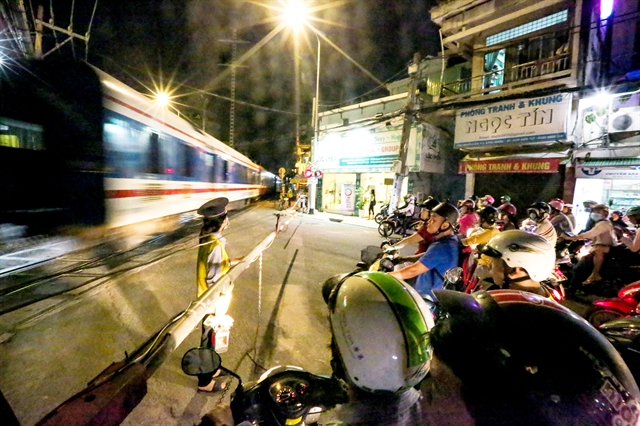 |
|
A railway worker during a night shift in Hanoi. |
Vietnam Railways has blamed a funding delay for the problem, saying many units have been forced to borrow money to pay for salaries and maintenance work.
Nguyen Thi Kim Thanh has worked as a level crossing operator at guarding area No1 of Đồng Văn Station under Hà Ninh Railways JSC for more than 10 years. She remembers every brand of trains and their schedules for passing through Hà Nam Province.
Amid the COVID-19 pandemic, the frequency of train operations has decreased due to the remarkably low number of passengers.
“Previously, my average income was about VNĐ5 million (US$217) per month, but from early this year, patrol staff and level crossing operators like me have only received VNĐ2 million ($87) per month,” she said.
“The company has owed our payments for four months.”
Thanh said the money was never enough for a family of four members and she and her husband had been forced to reduce their expenses to afford school fees for their two children.
At the end of every month, they have no money to buy meat for meals.
“I’m still lucky as all of my family members are healthy. We would surely be in debt if one of us had to be hospitalised,” she said.
Đào Thị Bích Liên, another barrier operator at Km87+630 point in northern Nam Định Province under Hà Ninh Railways JSC, said it was not the first time the company had failed to pay her on time.
Last year, the company owned salaries for months but managed to pay it back eventually.
Liên’s husband is a railroad maintenance worker and the couple earn a total of VNĐ4 million ($174) per month.
“We take more jobs to earn money to survive and wait for our payments to return,” Liên said.
Đậu Văn Long, chair of the Board of Hà Ninh Railway JSC, admitted the company has not signed a maintenance contract this year with Vietnam Railways Corporation. As a result, the company could not calculate its revenue or pay its employees.
The unit has about 600 employees and is responsible for maintaining 130km of track from Hà Nội’s Thường Tín District to Thanh Hoá Province.
Long said the company had to borrow roughly VNĐ5 billion ($216,950) per month from banks to pay minimum wages for staff.
“The company is trying to maintain operations while waiting for the ministries, branches and corporations to allocate maintenance funds,” he said.
Vũ Anh Minh, chairman of Việt Nam Railways Corporation, said the corporation spends about 90-92 per cent of its total capital on maintenance work. The rest is for tasks such as periodic repairs and inspections and overcoming the consequences of natural disasters and other unexpected circumstances.
Of the capital spent on routine maintenance, 69 per cent is used to pay wages to employees. The salary for railway patrollers and level crossing operators accounts for 48 per cent with an average of about VNĐ5.5-6 million per head per month. The remaining 52 per cent is for maintenance workers with salaries of VNĐ6-6.5 million per head per month.
However, railway maintenance is a public utility product and ordered by the State. Funding from the State budget for maintenance work only meets about 40 per cent of the demand and workers are the ones losing out.
The cause of the maintenance funding delay is a dispute between two government agencies – the Vietnam Railways Administration under the Ministry of Transport and the Vietnam Railway Corporation.
Last year, the Vietnam Railways Corporation was transferred to the Commission for the Management of State Capital at Enterprises (CMSC), an entity that manages the Government’s $43 billion worth of investment in various companies.
The CMSC refused to provide funds, saying maintenance workers should be paid by the Ministry of Transport since it controls the maintenance and infrastructure budget. However, the ministry cannot provide funds to an entity it does not manage.
Minh said the Government needed to come up with a solution to allocate the funding to ensure railway maintenance work as well as payments for employees.
The Vietnam Railways Corporation is assigned to operate the entire national railway system including 15 railway lines passing through 34 provinces and cities with a total length of 3,143km. — VNS

Railway struggling to survive, waiting for a new restructuring plan
Vietnam’s railway sector is struggling to cope with increasing challenges as it awaits a new restructuring plan.